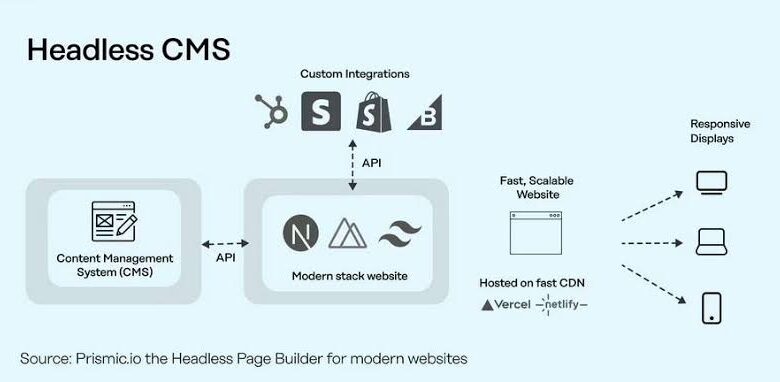Why Startups Should Use Headless CMS in 2025

For startups, every second counts. The difference between success and failure often comes down to how quickly you can get your ideas to market and adapt to the ever-changing digital landscape. As we step into 2025, the digital demands on new businesses are higher than ever before.
Customers expect smooth, consistent experiences across websites, mobile apps, and even smart devices. Investors want to see rapid growth and innovation. Teams need to collaborate efficiently, even when working remotely or across different time zones. In this high-pressure environment, the tools you choose can make or break your startup’s journey.
That’s exactly why startups should use headless CMS in 2025. Unlike traditional content management systems that tie your content and design together in a single, rigid package, a headless CMS separates the content management (the “back end”) from how your content is displayed (the “front end”).
This simple but powerful shift opens up a world of possibilities for startups. It means your developers can use the latest frameworks and technologies to build lightning-fast websites and apps, while your marketing team can update content instantly, no coding required. You can deliver your brand’s message everywhere your customers are, from social media to smartwatches, all from one central hub.
But the benefits don’t stop there. With a headless CMS, startups can launch new products and features faster, cut down on development costs, and scale effortlessly as their audience grows. Security is stronger, updates are smoother, and you’re never locked into outdated technology.
In a world where agility and innovation are the keys to survival, understanding why startups should use headless CMS in 2025 could be the smartest move you make for your business. In this article, we’ll break down exactly what a headless CMS is, why it’s such a game-changer, and how it can help your startup thrive in the digital age.
What is a Headless CMS?
A headless CMS is a modern content management system that separates the backend (where you manage your content) from the frontend (how that content is displayed to users). In simple terms, you store and organize your content in one place, and then send it out to any website, app, or device through APIs.
How does it work?
- Content creators and marketers add articles, images, and other information in the CMS.
- Developers use APIs to pull that content and display it however they want, on a website, mobile app, smartwatch, or even a virtual reality headset.
- This means you’re not locked into one way of showing your content, you have the freedom to use any technology or design.
Traditional CMS vs. Headless CMS

Traditional CMS: Everything is bundled together. The backend and frontend are tightly connected. If you want to change how your content looks or works on a new device, you often have to rebuild or duplicate everything.
Headless CMS: The backend is just for storing and managing content. The frontend can be anything you want, and you can update or redesign it without touching the backend.
This separation is a big deal for startups who need to move fast, try new things, and reach customers everywhere.
Read Next: How to Start an Online Store with No Tech Skills in 2025
Why Startups Should Use Headless CMS in 2025
Before diving into the details, let’s set the stage: In 2025, startups face more digital channels, higher customer expectations, and a need to grow quickly without wasting resources. A headless CMS offers the flexibility, speed, and scalability that modern startups need to survive and thrive.
Here’s why startups should use headless CMS in 2025:
1. Faster Time to Market
Startups live and die by how quickly they can launch new products or features. With a headless CMS, your frontend and backend teams can work at the same time. Developers don’t have to wait for content to be ready, and marketers don’t have to wait for developers to finish building pages. This parallel workflow can cut your launch time in half.
- No more bottlenecks, everyone works together, but independently.
- You can launch websites, apps, or even new digital products much faster than with traditional CMS platforms.
2. Lower Development and Maintenance Costs
Every startup wants to save money. Headless CMS platforms often come with built-in APIs and easy-to-use admin panels, so you don’t need a big backend team. Maintenance is also simpler and cheaper because there’s less complicated code to manage.
- No need to build everything from scratch.
- Fewer technical headaches and lower long-term costs.
3. Flexibility and Customization
With a headless CMS, developers can use any frontend framework they like, React, Vue, Angular, or something new that comes out tomorrow. This gives your team creative freedom to build unique, modern experiences.
- Marketers and content creators aren’t stuck with rigid templates, they can design content structures that fit their needs.
- You can easily adapt your digital presence as your business grows or changes direction.
4. Better Team Collaboration
Content editors, marketers, and developers no longer have to wait for each other. Editors can update content without needing help from developers, and developers can focus on building great user experiences.
- Everyone works in their own space, but the results come together seamlessly.
- Faster updates, fewer delays, and happier teams.
5. Improved Performance and Scalability
Because content is served through APIs, your website or app can load faster and handle more users without slowing down. You can also scale your frontend and backend separately, which is perfect for startups expecting rapid growth.
- Faster loading times mean better user experiences and higher engagement.
- Easily handle spikes in traffic or expand to new markets.
6. Omnichannel Content Delivery
Startups today need to reach customers everywhere, on websites, apps, social media, and even smart devices. With a headless CMS, you can manage all your content in one place and push updates to every channel at once.
- One update in the CMS can instantly appear on all your digital platforms.
- Consistent messaging and branding across every customer touchpoint.
7. Future-Proof and Ready for Growth
The tech world changes fast. A headless CMS makes it easy to switch to new technologies or add new platforms in the future without rebuilding everything from scratch. You’re not locked into one system, so you can adapt as your startup grows.
- Add new channels or redesign your site without touching the backend.
- Stay ahead of the competition by adopting new trends quickly.
8. Enhanced Security and Performance
Separating the backend from the frontend reduces security risks and gives you more control over how and where your content is delivered. Modern hosting solutions can cache and deliver your content faster, making your site more secure and reliable.
- Better protection against attacks.
- Faster, safer experiences for your users.
Real-World Examples and Use Cases
Startups around the world are already seeing big benefits from headless CMS:
- Launching New Products Quickly: Samsung Electronics Germany switched to a headless CMS to support both their mobile app and web platform for their membership program. This allowed them to respond faster to local market needs and cut the time to update pages in half, boosting user engagement.
- Updating Content Across Multiple Channels: With a headless CMS, a startup can update a product description once, and it automatically updates on their website, mobile app, and social media channels.
- Supporting Mobile Apps and Websites from One CMS: Startups can manage all their content in one place and deliver it to different platforms, saving time and reducing errors.
These real-world examples show how startups can move faster, reach more customers, and grow without being held back by old technology.
Read Next: Consulting That Moves You Forward: Why the Right Guidance Changes Everything
Challenges and Considerations
While headless CMS offers many advantages, it’s not without challenges:
1. Learning Curve: Teams new to API-driven systems may need time to learn how everything works. Training and onboarding are important, but the long-term benefits are worth it.
2. Initial Setup and Integration: Setting up a headless CMS and connecting it to all your platforms takes some work upfront. You may need experienced developers to get everything running smoothly.
3. Integration with Other Tools: You might need to connect your CMS to analytics, CRM, or marketing tools, which can add complexity.
4. Fewer Out-of-the-Box Features: Traditional CMS platforms often come with built-in features for design and layout. With headless CMS, you may need to build some features yourself.
Despite these challenges, most startups find that the flexibility, speed, and scalability of headless CMS far outweigh the initial hurdles.
Conclusion
In 2025, the digital landscape is more demanding than ever. Startups need to move fast, save money, and reach customers wherever they are. Headless CMS is the smart choice for startups because it delivers:
- Speed: Launch new products and features quickly.
- Cost Savings: Lower development and maintenance costs.
- Flexibility: Use any technology, design, or platform you want.
- Scalability: Grow your business without rebuilding everything.
- Future Readiness: Easily adapt to new trends and technologies.
If you want your startup to stay competitive and grow efficiently in 2025, consider making the switch to a headless CMS. It’s not just a tech upgrade, it’s a way to future-proof your business and deliver better experiences for your customers.
Frequently Asked Questions
1. What is the main difference between a headless CMS and a traditional CMS?
A headless CMS separates the backend (where you manage content) from the frontend (how content is displayed), allowing you to deliver content to any platform using APIs. Traditional CMS platforms combine both, limiting flexibility and making it harder to adapt to new technologies.
2. Is a headless CMS more expensive than a traditional CMS?
While the initial setup might require more technical expertise, a headless CMS often leads to lower development and maintenance costs in the long run. You save money by reducing the need for a large backend team and avoiding costly rebuilds when adding new platforms.
3. Can non-technical team members use a headless CMS?
Yes. Many modern headless CMS platforms offer user-friendly admin panels, so marketers and content creators can easily add or update content without needing help from developers.
4. What are the biggest challenges of switching to a headless CMS?
The main challenges are the learning curve for teams new to API-driven systems and the initial setup work required to connect all your platforms. However, the long-term benefits, speed, flexibility, and scalability, usually outweigh these challenges.



